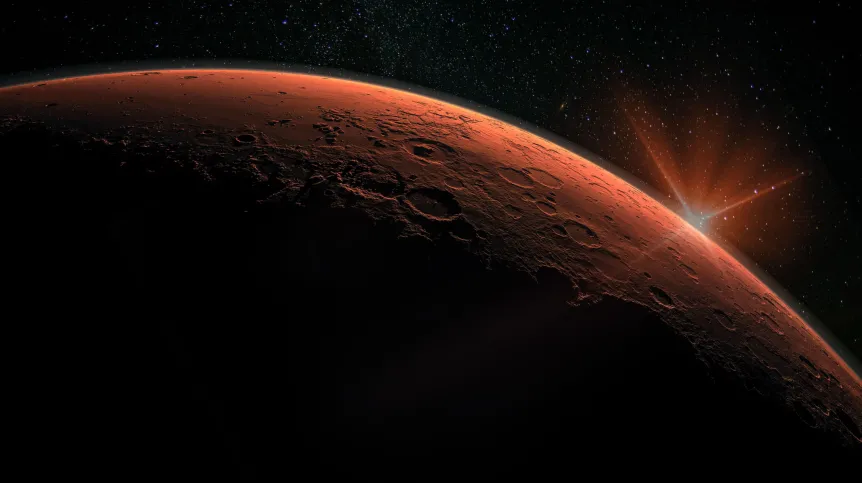
After Roscosmos has been excluded from the ExoMars mission, Astronika will take over the construction of a key component. It will be responsible for the ramp on which the rover will descend from the lander to the planet's surface.
Due to Russia's attack on Ukraine, the future of the important European ExoMars mission (current name is RFM – 'Rosalind Franklin Mission') was uncertain. The Russian Space Agency was excluded from this project.
However, thanks to the cooperation of Italy, France, the UK and Poland, the rover will most likely reach the surface of Mars in 2028. The Polish company Astronika will play a key role in this project. It will be responsible for building the ramp on which the rover will descend from the lander to the planet's surface.
Systems of this type have never been designed in Europe, the company emphasises. However, sending a European-Russian rover to Mars was planned 15 years ago. Roscosmos was to be responsible for building the rover landing platform and handling the landing process. The role of the Russians was partially taken over by Airbus, but a significant part of the responsibilities fell to Astronika.
'Our engineers have been given one of the key tasks - they are responsible for building a system that will allow the rover to safely leave the lander and reach the surface of Mars. The EGRESS system consists of four motorized ramps that must open precisely and allow the Rosalind Franklin rover to safely descend and begin exploration. (...) Our system must be absolutely reliable. The success of the entire mission depends on its correct operation. Without us, the rover will not start its journey on the Red Planet', says project leader Maksymilian Gawin.
'We are currently starting to work on the executive documentation and we are conducting talks with workshops that will help us produce parts of the first full-size model of the device, which will be tested in Astronika's laboratories in the fall of this year, and in December it will be sent to our client for tests at the system level', Gawin told PAP.
Final tests of the device are planned for next spring.
According to engineers, the task is full of special challenges. 'First of all, we have wind and Martian dust. We have to design our systems to be resistant to the weather at the landing site. Secondly, of course, we have to face the traditional challenge - stability versus the weight of the equipment. Our ramp cannot weigh more than 59 kg, but we cannot afford any failure in terms of stability. If the rover falls and overturns, the multi-million mission will fail’, says Gawin.
Another issue is planetary protection. Every part that flies into space must maintain high standards of cleanliness. 'If the mission's target is the Red Planet, these standards are even higher, and our team must ensure that absolutely no biological contamination reaches the surface of Mars. If we took any microorganisms there, scientists might one day +discover'+ them as extraterrestrial life’, Gawin says.
Meanwhile, one of the main goals of the mission is to search for traces of life. 'The Rosalind Franklin rover can make fundamental discoveries in organic chemistry, life sciences and comparative planetology because it will be the first to descend to a depth of up to two meters below the planet's surface, collecting samples protected from surface radiation and extreme temperatures', says Benjamin Rasse, Project Team Leader at ESA.
The mission will also demonstrate key technologies that Europe needs to master for future planetary exploration missions. These concern the ability to safely land on the planet, move independently on the surface and automatically perform drilling, processing and analysis of samples. The project is a huge opportunity for the broadly understood Polish space industry.
In the construction of the ramp, Astronika cooperates with the Space Research Center of the Polish Academy of Sciences, the Łukasiewicz Research Network - Institute of Aviation, Spaceive, the Warsaw University of Technology, as well as many other Polish entities. Each of them gains unique know-how that they will be able to use in future ventures. Therefore, it will be easier to secure further orders from ESA.
'Organizing cooperation between various companies and research institutes, both Polish and foreign ones, is one of the most interesting and developing aspects of participation in the ExoMars mission. Only when we join forces are we able to deliver the absolute most innovative technologies. When Polish entities cooperate as partners with giants such as Airbus or Thales, they gain invaluable experience and know-how for further ambitious ventures', Gawin told PAP.
Astronika's participation in the ExoMars mission also shows the benefits of knowledge acquired during previous contracts. 'The development of the technology used to build the ramp for the Rosalind Franklin rover is the result of many years of R&D work in our company. We have already practiced some of the solutions used here while designing mechanisms for the JUICE mission (which is currently on its way to the Jupiter system) and working on the legs for the lunar jumper', says Gawin.
The support of public administration is also important, including an increase of the Polish contribution to ESA, the company emphasise. (PAP)
Marek Matacz
mat/ bar/ kap/
tr. RL













